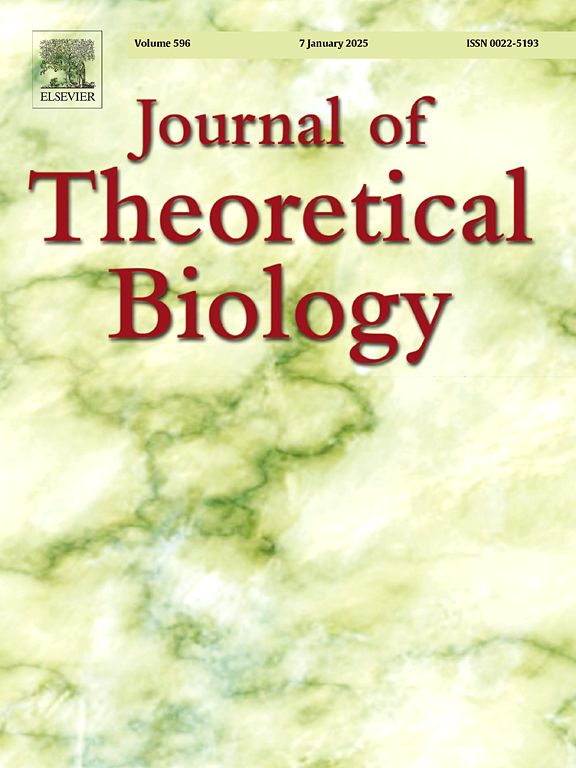Estimating the contribution of age-structure to the COVID-19 epidemic in England
IF 1.9
4区 数学
Q2 BIOLOGY
引用次数: 0
Abstract
The spread of epidemics in populations is often inhomogeneous, consequently infection incidence varies between sub-populations. Age-structure is often particularly important in the dynamics of epidemics, due to the contact patterns between individuals of different ages. Public health interventions are often targeted at specific age-groups, therefore analysing the age-structure of transmission patterns is essential to evaluate the efficacy of these interventions. We develop a Bayesian model to estimate the contribution of different age-groups to the reproduction number (R) and to new infections for COVID-19 in England throughout 2021, using the ONS Infection Survey. We model a dynamic next-generation matrix in a novel way by splitting it into a static survey-derived social-contact matrix, multiplied by a low-rank dynamic matrix. We show that whilst R was typically highest for school-age children (5–11y and 12–17y) and lowest for the elderly (60y+), the former typically rose during term-time and fell during the school-holidays. The dynamics for young adults (18–29y) were particularly interesting, which increased relative to older adults in late-spring 2021 following the re-opening of entertainment venues. The R peaked for young adults in July 2021 coinciding with the period of the Euros football tournament, before rapidly dropping as the national vaccination program reached this group in August 2021. Our model is an important tool that can estimate R and attribute new infections by the infector’s age, thus identifying core groups which sustain the epidemic and informing the design of targeted interventions.
估计年龄结构对英格兰COVID-19流行的贡献。
流行病在人群中的传播往往是不均匀的,因此感染发生率在亚人群之间有所不同。由于不同年龄的人之间的接触模式,年龄结构在流行病的动态中往往特别重要。公共卫生干预措施往往针对特定年龄组,因此,分析传播模式的年龄结构对于评估这些干预措施的效果至关重要。我们开发了一个贝叶斯模型,利用英国国家统计局的感染调查,估计不同年龄组对2021年英格兰COVID-19的繁殖数(R)和新感染的贡献。我们以一种新颖的方式将动态下一代矩阵划分为静态调查衍生的社会接触矩阵,乘以低维动态矩阵。我们发现,虽然学龄儿童(5-11岁和12-17岁)的R通常最高,老年人(60岁以上)的R最低,但前者通常在学期期间上升,在学校假期期间下降。年轻人(18-29岁)的动态特别有趣,在娱乐场所重新开放后的2021年春末,相对于老年人,这一动态有所增加。年轻人的R值在2021年7月达到峰值,与欧洲足球锦标赛期间一致,然后随着2021年8月国家疫苗接种计划覆盖这一群体而迅速下降。我们的模型是一个重要的工具,可以根据感染者的年龄估计R并归因于新感染,从而确定维持流行病的核心群体,并为有针对性的干预措施的设计提供信息。
本文章由计算机程序翻译,如有差异,请以英文原文为准。
求助全文
约1分钟内获得全文
求助全文
来源期刊
CiteScore
4.20
自引率
5.00%
发文量
218
审稿时长
51 days
期刊介绍:
The Journal of Theoretical Biology is the leading forum for theoretical perspectives that give insight into biological processes. It covers a very wide range of topics and is of interest to biologists in many areas of research, including:
• Brain and Neuroscience
• Cancer Growth and Treatment
• Cell Biology
• Developmental Biology
• Ecology
• Evolution
• Immunology,
• Infectious and non-infectious Diseases,
• Mathematical, Computational, Biophysical and Statistical Modeling
• Microbiology, Molecular Biology, and Biochemistry
• Networks and Complex Systems
• Physiology
• Pharmacodynamics
• Animal Behavior and Game Theory
Acceptable papers are those that bear significant importance on the biology per se being presented, and not on the mathematical analysis. Papers that include some data or experimental material bearing on theory will be considered, including those that contain comparative study, statistical data analysis, mathematical proof, computer simulations, experiments, field observations, or even philosophical arguments, which are all methods to support or reject theoretical ideas. However, there should be a concerted effort to make papers intelligible to biologists in the chosen field.

 求助内容:
求助内容: 应助结果提醒方式:
应助结果提醒方式:


